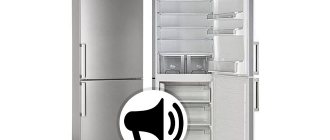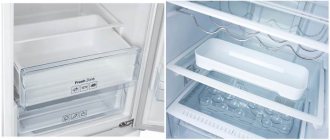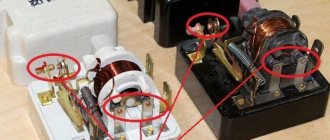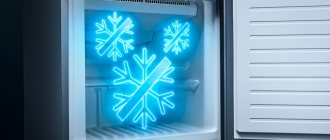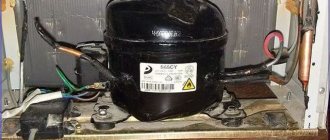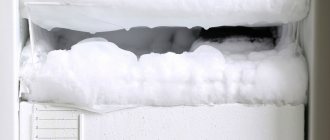Why does the refrigerator click during operation?
Refrigeration unit breakdowns are far from a rare occurrence among household appliance problems. If the unit makes clicking noises during operation, it is worth investigating and solving the problem in a timely manner. There are cases when all that is required is defrosting the unit, after which the characteristic sounds disappear once and for all. Let's figure out why the refrigerator clicks during operation for several reasons and what it means.
- Operating sounds are normal
- What kind of malfunctions can there be?
- What to do
Most often, customers contact our company with the following complaints about their refrigerators:
The No Frost refrigerator clicks.
If you encounter any problem described in this material, you can first make sure for yourself that it is not a breakdown by following our recommendations. Or determine what malfunction has occurred in your refrigerator, and feel free to call a specialist - you already know how complex the repair will be and how much it will cost you. Do not forget to order an accurate diagnosis; perhaps, along with the clicks, your refrigerator was overcome by other malfunctions in the systems and components. And professional technicians will help you cope with any failures and problems with your household appliances.
Often, owners of refrigerators, the most modern models, ask a painful question: why does the refrigerator click when turned on? Sometimes it works, but in the worst case scenario, the refrigerator clicks but does not turn on. Why is this happening and what to do? Such questions arise not so rarely, and concern any brands and models. People are looking for an answer to the question why the Indesit, Atlant, Ariston, Veko, Samsung, Bosch, Liebherr, and other brands of refrigerators click.
Operating sounds are normal
Refrigeration devices normally produce dull, quiet, ringing, rumbling sounds. Some devices are programmed to make characteristic low sounds before turning the engine on or off.
Frequent quiet and loud clicks, accompanied by hum and rumbling, require special attention from refrigeration technicians.
Quiet knocks heard during the compressor rest period indicate deformation of the metal walls of the frame (due to ice pressure exerted on the structure) during the heating and cooling process. This characteristic feature does not lead to breakdowns of the main parts, but it is highly advisable to pay attention to eliminating the cause.
Another common cause of clicking sounds is the capillary tube located at the bottom rear of the device. During the defrosting process, the device stops making clicks, but later the sounds appear again.
When the engine is running, the spiral tube becomes resonant, resulting in a characteristic quiet, rapid "thump" on the engine. A method for eliminating unpleasant sounds is to take a match and insert it between the walls of the engine and the spring.
Start of diagnostics
The first thing you need to do is see if the refrigerator turns on and if it holds the desired temperature. There are three options:
- the refrigerator turns on, the motor runs, the desired temperature is reached;
- the refrigerator turns on, there is the sound of the motor, but the desired temperature is not reached;
- The refrigerator does not turn on, the engine does not start.
In the first case, most likely, the clicks are associated with deformation of the plastic parts during heating and cooling. This is a design feature that should not bother you. The clicking sound may be coming from the thermostat sensor. Some models are inherently noisier than others.
It’s worse if the refrigerator “doesn’t cool” or the motor doesn’t start at all. In this case, you cannot do without contacting a specialist. Let's consider all cases in more detail.
What kind of malfunctions can there be?
A relay is a design that partially controls the operation of the unit and is the first to start in the power circuit. If there is no light in the on mode and unpleasant sounds are made, then an urgent replacement of the start-up relay is necessary.
A common cause of refrigerator clicking is a loose motor mount. Occurs from stretching of belts. This problem appears due to improper care (incomplete defrosting, the ice does not melt completely and the device is connected to the network again), and premature overload of the belts occurs from insufficient rest of the unit, due to infrequent defrosting.
Refrigerator motor
When the motor is in rest mode, it comes into contact with the inner wall of the unit, making clicking noises at a rapid pace. You can correct the situation with your own hands by slightly tilting the refrigerator so that the motor does not come into contact with the body. If the clicks remain, you need to adjust the location of the spring, which is located inside the device.
If, in the event of a compressor breakdown, clicks are heard, the unit does not freeze at all, and the light does not light up, this indicates a serious malfunction. The function of the compressor is to compress air for further transmission to another section of the unit.
A thermostat is a device that transmits a signal about temperature changes to the control unit, which subsequently responds to the engine by turning it off or igniting it. If it breaks, you need to replace the thermostat with a new device; in this case, the clicks will disappear.
Doesn't work, but clicks
- Another reason why, for example, the Indesit unit clicks but does not turn on is problems in the thermostat. When turned on, it must send a command to the control module to start the motor. The thermostat always clicks when the unit is turned on, but if the unit does not work after that, the problem is 90% in it.
- It happens that, for example, the Atlant refrigerator clicks, the engine starts to start, but stalls. At the same time, it can buzz loudly for a certain period of time. Most likely, the problem is with the motor-compressor; it will definitely need to be replaced.
- The relay is one of the first mechanisms of the unit to come into operation when it is turned on. If the refrigerator relay clicks, but it does not start working, the light in the chamber does not light, you most likely need to change the protective relay.
- The simplest problem of extraneous noise in the unit that most owners encounter is when clicks are heard in it before the engine stops completely. At the same time, both the regular and freezer compartments operate in accordance with the specified technical characteristics, and there are no problems with the internal lighting of the unit. In this case, the motor mounts are presumably loose, and when it stops, it comes into contact with the body.
You can solve the problem on your own - by slightly changing the angle of inclination of the unit. And if this is not enough, then make additional adjustments to the springs supporting the compressor. You can also do this yourself, but it is better to call a specialist - this is usually the cheapest service from refrigerator repair companies.
What to do
Any compressor can be scanned with a tester to identify the causes of failure. An old compressor can be repaired, but it is easier to replace it with a new device.
To avoid breakdowns, you need to avoid power surges by adjusting the optimal power supply.
Refrigerator repair
It is undesirable to start repairs on your own due to the lack of the necessary knowledge base. Let professionals deal with serious problems.
Subscribe to TechnoCouncil on social networks so you don’t miss anything:
Normal, working sounds
The refrigerator constantly or periodically crackles, gurgles and clicks during operation, but at the same time it functions completely normally:
- the required temperature inside the chambers;
- water does not leak anywhere;
- no smell of burnt plastic;
- The display (if present) does not show any errors, only operating parameters.
This means that all the sounds that the unit makes are completely natural and should not be a cause for concern.
For example, crackling sounds and quiet clicks can be produced by elements of the cooling circuit and the unit housing. They contract and expand due to temperature changes, hence the unusual sounds. Listen to the crackles and clicks of your freezer drawer when you pull it out into the warm environment. The rest of the refrigerator parts “sound” exactly the same. As a rule, this crackling noise begins a few minutes after the engine is turned off.
When the compressor is turned on (when the refrigerator starts up and starts humming), the thermostat clicks. With this click he turns on the motor. The same thing repeats when turned off: a click and the compressor stops humming.
What to do? Don't worry, but keep a close eye on the refrigerator for a few days. You must be 100% sure that it is working properly. After all, it may be that the unit broke down and started clicking only today, so the temperature in the chambers has not yet had time to rise, and there are simply no other symptoms.
Important! It is normal for the refrigerator to make clicking sounds from the first day of operation. Over time, they may gradually get worse. If previously the unit worked almost silently, but today it suddenly clicks strongly and loudly, call a technician. Such sudden changes in the operation of household appliances indicate malfunctions. It’s better to play it safe right away than to wait for complications and then pay for more expensive repairs.
Problems with the motor-compressor
There are several options here. Carefully observe the operation of the refrigerator and determine which description best suits your case:
- The refrigerator clicks but does not work. After each click, the engine tries to start, but stalls almost immediately. Then the unit “rests” for some time, and the startup attempt is repeated.
- The motor turns on, the refrigerator hums for a while, but does not work. Then the start protection relay clicks loudly and the compressor turns off. At the same time, the refrigerator does not freeze at all. There may be a smell of overheated or burnt plastic.
- Just before shutting down, the compressor clicks once, clearly and loudly. Otherwise, everything looks quite normal - the temperature in the chambers is maintained at a given level.
The first two cases are similar. Their symptoms indicate engine failure. It is either unable to start at all, or it “spins” but quickly overheats. An audible click is the activation of the start-up relay, which forcibly turns off the motor when it overheats.
The only solution to this problem is to replace the compressor. It's expensive, but still cheaper than buying a new refrigerator. In some cases, it is also possible to repair an old, broken motor. But, be that as it may, one cannot do without a master.
But the last case is simpler. Most likely, the compressor did not break, but only became loose. More precisely, under the influence of constant vibrations, its fastenings became loose. As a result, during operation, the motor “swings” on its springs so much that it touches the housing elements and turns off. At this moment a click is heard.
What to do? You just need to adjust the position of the compressor. First of all, try tilting the entire refrigerator back or forward a little. It will level out, vibrations will decrease, and the compressor will not swing as much. If this does not help, you should call a specialist. It will tighten the springs that support the motor, and the problem will disappear. The main thing is not to delay repairs, otherwise the compressor may simply burn out.
Thermostat malfunction
The refrigerator clicks periodically, but the motor does not turn on. Due to the constantly switched off compressor, the unit does not cool or freeze, the temperature in the chambers rises. Apart from clicking, no sounds are heard at all. At the same time, the clicks themselves are quite loud. The light in the camera is on and the indicators are on.
This set of symptoms indicates a thermostat failure. It clicks when the temperature in the chamber exceeds the set temperature. But normally, after this click, the motor turns on and cooling begins. A broken thermostat cannot send the command to start to the compressor, and the refrigerator does not work. The faulty part must be replaced. Some home craftsmen do this on their own, but it’s easier and more reliable to call a professional.
Breakdown of the start-protection relay
From time to time the refrigerator clicks clearly, but nothing else happens. The motor does not turn on, the fan in models with No Frost does not work, and even the light in the chamber does not shine. It seems that “the whole refrigerator” has broken down. But this is just a breakdown of the start-up relay. It is enough to replace it to make everything work again.
Power surges
The compressor hums, that is, it works normally, and then turns off just as normally to “rest.” But at the end of this rest, when it’s time to turn on again, the engine does not start immediately. There is a loud click and then silence. After a pause, the refrigerator clicks again, but does not turn on. This can be repeated several times.
In the end, after the next click, the engine starts and works as if nothing had happened. In the next cycle it may click again, or it may start the first time. Despite all this, the unit cools normally, and there is light in the chambers.
The reason for this behavior of the refrigerator is very low voltage in the electrical network. Each click is an attempt by the start-up relay to turn on the motor. If there is enough voltage, then the compressor will start working with the first click. If the current is too weak, there is simply not enough to start the motor. The problem can be either permanent (when the voltage is always low) or temporary (occasionally surges occur in all electrical networks).
What to do about it? If possible, measure the current in the network to finally make sure that the cause of the clicks lies there. If such a problem arose for the first time and did not last long, you can do nothing at all. Perhaps the surges will not happen again.
But for those who are connected to old or constantly overloaded power networks, experts recommend purchasing a current stabilizer. Manufacturers, by the way, also urgently require that the refrigerator be connected to a network with a stable voltage. Otherwise, they even refuse warranty obligations. Buy a stabilizer - it will extend the life of your refrigerator.
The last problem is the easiest to fix. You can easily deal with it yourself. But if the clicking noises are caused by a malfunction of the refrigerator itself, you should call a technician. Repairing complex components with your own hands is very dangerous, because you can simultaneously touch adjacent parts and greatly worsen the condition of the equipment.
To get rid of annoying clicking noises forever and return your refrigerator to working order, contact Kholodok. Our technicians will professionally repair or replace any faulty component, adjust the operation of the unit, and it will stop clicking. Call us or leave a request describing the problem here.
Features of warranty service
There is some good news. Nowadays, almost all household appliances are sold under warranty, which means that they are under warranty service for 6-24 months (depending on the manufacturer and company policy). In this case, replacement of incorrectly working or failed parts is carried out under warranty, that is, free of charge, if the conditions for providing the service have been met.
After such repairs, the refrigerator continues to work stably for many years, even after the warranty has expired. That is why it is so important to purchase licensed products, the quality of which is confirmed by the warranty service.
So, knowing the causes of the problems and having read the methodological guide loudly titled “How to act if the refrigerator is cracking,” you can easily get rid of such a problem with your own hands or by resorting to the help of a specialist, as you see fit.
- home
- ›
- Articles
It’s probably no secret to anyone that refrigerators make certain sounds when operating. Some people are used to the rumbling of the refrigerator, others hear the sounds of circulating freon from the unit, and others do not pay attention to this kind of noise at all. But if the refrigerator begins to click during operation, which is usually unusual for it, then it is difficult not to notice. The first thing that owners of household appliances think is that the device is really broken?!
Before you give the verdict “Broken!” and call a specialist, it won’t hurt to check the device yourself - maybe nothing is broken in it. First you need to determine whether the unit is freezing. If at first glance everything is in order with the refrigerator, the temperature corresponds to the set temperature in both chambers and you are only concerned that the refrigerator makes extraneous clicks, then several reasons may contribute to this process.
1. If you hear clicking sounds when the compressor is “resting,” then such sounds may be coming to your auditory receptors due to deformed materials during the cooling and heating processes. The cracking noise can come from both plastic parts and the “crying” evaporator tube. You should not be afraid of such noises - they arise due to the design of your refrigeration unit. The manufacturer provides for the possible expansion and contraction of certain materials and such processes do not lead to breakdowns.
2. Clicking noises when turning the refrigerator on or off are most likely due to the fault of the temperature controller. In some models of refrigerators, especially older ones, the temperature sensors are quite loud and can be heard quite well, and this cannot be classified as a malfunction. But if this is about your refrigerator, then remember that it should start clicking from the first hours of operation, and not after months and years of operation.
If the refrigerator has never played the role of the “Nutcracker” before, or in addition to the fact that the refrigerator makes sounds, it also does not freeze, or other problems are observed in the operation of the unit, then a breakdown is a very likely scenario for you. Since, in addition to the harmless reasons listed above, clicks may also appear due to the fact that the refrigerator has encountered a number of malfunctions.
- Symptom: a clicking sound is heard in the refrigerator on the electromechanics, accompanied by the fact that the compressor does not turn on. Reason: Most likely, a thermostat failure should be considered as a malfunction. In working condition, this sensor informs the control module about the temperature in the chambers, and it, in turn, does not give the command to the unit to start working. As a rule, the operation of the thermostat is characterized by clicking, but if this is accompanied by the fact that the motor does not turn on (and it does not make noise if it does not work), then you simply hear these clicks more clearly. Action: The thermostat needs to be replaced.
- Symptom: when you turn on the refrigerator, you hear clicking sounds - the motor is trying to turn on, but fails. The light in the refrigerator compartment is on.
- Symptom: there is no light in the refrigerator, you hear clicking sounds, the compressor does not work. Reason: The fault may lie with the start-up relay. If there are problems with the relay, this is often accompanied by the fact that the light in the refrigerator does not turn on (but it doesn’t hurt to check if the light bulb is burnt out). Action: The broken part needs to be replaced.
- Symptom: Clicking noises are heard before the engine turns off.
Reason: if you hear sound signals before the compressor turns off, this indicates that the compressor fastenings may have become loose, so when it stops, it touches the housing and you hear various sounds, including clicks. Action: try changing the tilt of the device body. If this does not change the situation, you can try to adjust the springs that hold the motor-compressor.
Why does the new refrigerator crack?
The refrigerator is not a silent device. The equipment is constantly noisy due to its powerful engine. However, sometimes it happens that extraneous sounds are heard that were not there before. Most often, owners observe clicking sounds. In most cases, experts do not consider them problems. But it’s better to find out why the refrigerator is cracking in order to take the necessary measures.
When clicking is not a problem
If your refrigerator clicks, it's not always a cause for concern. When sounds are clearly audible after shutdown and defrosting, they indicate deformation of the material as the temperature in the chambers changes. This is normal and no repair is required. This is typical for recently purchased units. Over time the noise will disappear.
Clicks can come from chamber walls, tubes, and plastic parts. Experts do not classify them as deviations in the operation of equipment. This is observed due to temperature differences. As soon as the optimal mode is established inside the unit, the sounds will stop.
The temperature controller in the refrigerator may click. This phenomenon is typical for models with a mechanical control system. Sounds are heard from the very beginning of operation, so they do not require attention. Perhaps over time the parts will work out and the rustling will become less loud.
To make sure the equipment is working properly, you need to do the following:
- inspect the unit inside and out;
- check if the cameras are freezing;
- see if there is water under the device;
- Examine the control panel for errors.
If there is no smell of burnt plastic, there is no cause for concern. However, you should watch the technique. If the clicking becomes more intense, you need to call a specialist for diagnostics.
When new equipment crackles during operation, this is considered normal.
The parts are worn in to each other, and the materials are adapted to low temperatures.
Within 2-4 weeks the cracking should disappear. If it does not stop, you should contact a service center for diagnostics. A number of models have a characteristic sound when operating and there is nothing to worry about.
Appliances may make unusual noises due to circulating freon. Ariston and Samsung refrigerators, which belong to the budget class, have this feature. Nothing can be done about this problem; it does not disappear over time.
No reason to worry
There are two main reasons for a refrigerator to click during operation, which do not affect its performance.
- Plastic parts and tubes change in size and deform when heated and cooled, making unusual sounds. In this case, clicks will occur immediately after turning the unit on and off. The developers took such deformations into account, so they usually do not lead to failure.
- Clicking noises may accompany the operation of the thermostat. Some models initially produce loud sounds. This is your option if your new refrigerator begins to crack from the very first day of operation.
If previously the equipment worked quietly, but now it clicks during operation or has become very loud compared to previous periods, you will need to contact a workshop.
Malfunctions and what to do
Extraneous noise emanating from equipment in some cases indicates failure of parts or malfunctions. To understand why the refrigerator clicks, you will need to consider additional factors. They will help you identify problems and find a way to fix them. At the same time, repairs are not always expensive; replacement of some parts does not exceed 3,000 rubles.
The start protection relay is broken
When clicks are heard periodically, but the engine does not start, it is dark in the refrigerator compartment, this indicates a failure of the relay. The mechanism cannot be repaired; replacement is required.
It is difficult to carry out repairs on your own. It's better to entrust it to a professional. When the master installs a new part, the extraneous noise will disappear. A similar problem most often occurs in Hotpoint and Samsung equipment equipped with the No Frost system. However, the cost of repairs is low: it reaches 1,500 - 3,000 rubles. depending on the model.
When the refrigerator clicks during operation, but the engine starts, the start-up relay has nothing to do with it. Equipment often reacts this way to temperature changes. You need to close the door more tightly and not keep it open unless necessary.
Refrigerator compressor turns on and off immediately
Different models of refrigerators from Bosch, Sharp, Gorenje, Siemens differ in operating and downtime times. It also depends on the room temperature, the presence of heating devices near the device, and the set temperature regime. If the refrigerator compressor turns on and turns off after a few seconds, then the unit is faulty.
The refrigerator is operational when operating for 11 minutes and resting for 15 minutes, but 2 minutes of operation after 15 idle minutes is far from normal. When operating this way, the appliance does not reach the set temperature, which has a bad effect on food storage; repair of the refrigerator at home is necessary.
Main malfunctions of refrigerators in operating mode:
- The start-up relay, which protects the motor from overloads, is faulty. The refrigerator turns off and users hear a clicking sound. A part needs to be replaced.
- The electric motor has failed: the internal winding has broken; a specialist must be called.
- The compressor heats up due to the fact that the start relay winding breaks, and the refrigerator turns off. In this case, the part cannot be repaired. Replacement cost depends on the model.
Where to start looking for the cause?
If you notice that the refrigerator clicks when operating, first check how it generally works. There are two options here:
- Apart from strange sounds, the equipment does not show any symptoms of failure. In both chambers - the refrigerator and the freezer - the temperature is normal. In this case, there is no need to worry too much - most likely, the clicks are part of the normal sound of the unit.
- The refrigerator clicks but does not work. It either does not start at all, or it turns on, hums, but does not freeze (the temperature in the chambers is increased). Other symptoms are also possible. This already indicates the presence of a serious breakdown.
Let's take a closer look at the specific causes of clicking sounds.
When clicks are not a problem
Normally, the refrigerator may click in the following cases:
- After the compressor is turned off. When the chambers are cooled to the desired temperature, the motor turns off and the refrigerator stops humming. And during “rest” the unit periodically clicks, crackles, and taps. These sounds are produced by plastic and metal parts that contract and expand with temperature changes. For example, this is how a freezer drawer clicks when you take it out and put it in a warm kitchen. All this is normal and will not harm the refrigerator - temperature deformations of the materials are taken into account in its design.
- When turning the motor on and off. At this moment the thermostat clicks. Depending on the model and brand of your refrigerator, it may sound louder or quieter.
The following is very important here: sound should accompany the operation of the unit from the very beginning, from the day of purchase. Then the clicks are considered not a breakdown, but a feature of the model. A malfunction is possible in the following cases:
- Previously, the refrigerator worked silently, but then suddenly it started clicking.
- Before, the clicks were quiet, but now the unit clicks very loudly and loudly.
With such unexpected changes in the operation of the equipment, you need to contact a specialist .
Malfunctions that cause the refrigerator to click
But the signs listed below indicate serious problems. They must be eliminated in order for the refrigerator to continue to function normally.
| Symptoms | Possible problem | How to fix the problem |
| The refrigerator clicks periodically, but the motor does not start. There is no light in the cell. | The start protection relay is broken. | Replace the relay ( call a technician ). Cost from 750 rubles. |
| Periodic clicking sounds are heard. The engine does not turn on, but the light in the refrigerator is on. | Thermostat is faulty. It must transmit a command to start the motor when the temperature in the chamber becomes higher than the set one. If there is a malfunction, the thermostat cannot do this. It often happens that the unit clicks normally, but after a breakdown the clicks immediately become much louder. | Replace the thermostat ( call a specialist ). Replacement price is from 850 rubles. |
| The refrigerator clicks, then the engine starts. It hums, but does not work and soon turns off with a characteristic loud click (this is how the start-up relay clicks). In other cases, the compressor just tries to start and immediately stops. | The motor-compressor is broken. It tries to work, but overheats. Immediately the start-up relay is activated: there is a click and the motor is knocked out. Then there is silence in the refrigerator until the next startup attempt. | Replace the motor-compressor (you need to call a specialist ). Price - from 820 rubles. |
| The refrigerator is working normally (the temperature in the chambers corresponds to the set temperature, the light turns on). The compressor clicks before switching off. | Loose compressor mounts. This happens due to improper installation of the unit and the vibrations caused by it. The motor stays in place less easily. Stopping operation, it comes into contact with the body of the refrigerator. At the same time, one loud click is heard. | First, you should change the position of the refrigerator, slightly changing its tilt relative to the vertical. It is quite possible to do this yourself. If the clicking does not stop, call a technician to adjust the springs holding the compressor. You should not postpone the adjustment, as over time the situation will only worsen and the motor may fail. Price from 600 rub. |
| When the compressor is turned off, several loud clicks with short pauses are heard. With the last of them, the motor starts, and then the refrigerator operates normally. The temperature and lighting in the cells are also normal. | Low voltage in the network. The start-up relay tries to start the engine, but there is not enough current to do so. The relay will continue to try until the motor starts running. After the compressor completes its cycle and turns off, the refrigerator may click again, or it may start without problems the first time. | Install a stabilizer to provide the refrigerator with normal voltage. Otherwise, during the next surge, any component may break - from the relay to the compressor. |
You can fix some problems yourself. But it’s better not to undertake complex repairs and replacement of expensive spare parts - this work is for professionals. Moreover, you can easily get rid of any breakdowns by calling a good refrigerator repairman to your home. Call Formula Cold or leave a request directly on the website. We will quickly repair your refrigerator - it will work again as quietly and diligently as in the first days after purchase.
More serious problems
Sometimes components of the device fail. This leads to the fact that the microwave oven does not heat, despite the spinning glass tray and the light burning inside the device.
Bad fuse
A fuse is needed in microwaves to protect against damage to more important, expensive parts. As a result of its location in a high-voltage circuit, it is often hidden in a protective casing. The fuse consists of a transparent glass bulb with metal caps on both sides. A wire is soldered to them, twisted in the form of a spring, which cannot burn out.
The failure is limited to solder failure on one side or the other of the cap. The integrity of the chain is broken. You can fix the problem by removing the cap and soldering the torn wire to it. Having assembled all the components of the fuse, turn on the device and check whether it heats up.
Magnetron problems
- Weak contacts that may malfunction due to constant heating. By squeezing them a little with pliers you will be able to get the device working;
- In some cases, the microwave does not work because a drop of frozen metal or traces of burning appears on the cap of the magnetron antenna. Fine sandpaper will help get rid of this. Treat the entire cap, polishing it until it shines. The better the conductivity of the cap, the better the microwave or other manufacturer will work;
- If the antenna cap has a hole, you need to remove it and check whether the metal underneath is intact. If the material is intact, the magnetron works. In this case, you just need to replace the cap. If the metal above the magnetron is damaged, this part of the microwave automatically fails. In this case, the magnetron can be changed (it is very expensive) or you can buy a new microwave oven.
Problems with mica paste
If the microwave stops heating, pay attention to the condition of the mica plate. A large amount of fat and soot on it interferes with the normal operation of the device.
In some cases, even sparks and a characteristic crackling sound may be observed. When heavily polluted, fires often occur, threatening people's lives.
This problem must be resolved immediately. To do this, unscrew the screws on the mica plate and, using fine sandpaper, ideally clean its surface. After this, screw it into place and turn on the microwave, checking whether the repair was carried out correctly.
If there is a hole in the plate, sparks and an unpleasant odor appear inside the household appliance. Then the plate should be replaced with a new one.
Capacitor burnt out
If the microwave starts to make a lot of noise when you turn it on, there is a possibility that the capacitor has burned out. You can check its serviceability using a tester. When there is little or no resistance, the capacitor will have to be replaced.
The diode has failed
A breakdown of the diode can be indicated by heating of the capacitor when the microwave oven is turned on or a strong hum. The diode cannot be repaired, so they throw it away and buy a new one.
Transformer failure
A large amount of smoke indicates a transformer malfunction. However, it may not be there, and the device will still not heat food
Therefore, it is important to check the transformer winding. Its normal voltage when the stove is on is 220 V
If the voltage drops during measurements, the reason may be an interturn short circuit that has occurred in the windings.
A transformer that can no longer do its job properly is replaced with a new one or rewound, which requires special skills and effort. Otherwise, the stove will heat poorly or remain faulty.
Faulty inverter
Inverter appliances, such as LG models, may experience operational problems. The meaning of inverter control is to change the temperature using sensor devices. The inverter determines the degree of heating of the food and forces the microwave to operate in the desired mode. This microwave component can be replaced with a new one.
The main reasons why the refrigerator cracks or clicks during operation
During operation, the refrigerator always makes sounds, since the device consists of complex mechanical components. But sometimes new sounds are added to the usual ones - clicking and crackling. Some owners begin to worry about the condition of the equipment, because increased noise can not only cause discomfort, but also cause breakdowns. To understand the situation, you need to study possible factors that can affect the appearance of crackling.
When does a cracking sound indicate a breakdown?
A refrigerator is a household appliance that produces extraneous sounds during operation due to its powerful motor. Most often you can hear a cracking sound. In most cases this is not a problem. But sometimes it may indicate a technical malfunction. To figure out why the refrigerator is cracking, you need to study the probable causes of the noise.
Note! If the cracking does not stop for several months, you need to seek help from specialists.
Unit owners should contact a service center if:
- the engine does not start during a crackling or clicking sound;
- there is no light in the refrigerator compartment;
- the refrigerator is crackling, but not freezing;
- during the crackling sound, the engine hums and there is a burning smell;
- loud sound before shutting down;
- The relay clicks, preventing the engine from starting.
If the equipment is new, in most cases the crackling sound is considered normal. Materials adapt to low temperatures. If the refrigerator is many years old, some parts may break.
It crackles but doesn't work
- The reason why the Atlant refrigerator is crackling but does not turn on may be a malfunction of the thermostatic relay. At the moment of switching on, this node sends a command to the control module, which causes the motor to start. Clicks when the thermostat starts up are present in any case, but when the relay clicks and the refrigerator does not turn on, it means that the reason is 92% there.
- Why does the Hotpoint Ariston refrigerator crack? It happens like this: there is a click inside, the engine starts to start, but after a few seconds it stalls. This process may be accompanied by a loud, dull hum for a certain period of time. In this case, most likely the problem is in the motor-compressor, which needs to be replaced.
- The relay is one of the first mechanisms that comes into operation when the equipment is turned on. If you hear clicks, the refrigerator does not turn on, and the light in the compartment does not light up, most likely the problem is in the protective relay.
- In some cases, noise-causing clicks emitted by one of the refrigerator components are heard when it is turned off, when the motor stops. At the same time, all departments of the refrigerator continue to operate in accordance with technical indicators, and there are no problems with the internal lighting of the departments. In this case, there is reason to suspect that the motor mounts have become loose, and when it stops, the unit comes into contact with the body, which causes sounds like clicks to appear.
What to do in this case
What can constantly click in a running refrigerator? Problems in the operation of freezing equipment can be divided into mechanical (damage to gaskets, housing, depressurization of cooling tubes) and electrical (breakage of the motor, power relay, fan).
In the first case, you can try to fix the problem yourself. If the refrigerator begins to make noise or crackle when turned on, this is most likely an electrical type of failure. It is impossible to fix the problem on your own. In this case, you will need the help of a qualified technician.
Will the repair cost a pretty penny?
In modern refrigerator models, most operational defects are easily eliminated thanks to the masters of their craft and a wide range of parts and analogues on the responsible market. The average cost of repair work to restore the functionality of a refrigerator is not so high. Everything will cost approximately 6,500 rubles (depending on the model) when replacing a faulty compressor motor - the most expensive component in the unit. Replacing a relay or thermostat will cost half as much - about 3,000 rubles.
The main causes and ways to eliminate refrigerator crackling
Why there is a cracking sound in the refrigerator, only people who understand the device will answer with accuracy. Extraneous sounds during operation of the refrigerator do not always indicate its breakdown. In some cases, you can eliminate them yourself. The main thing is to understand the factors that provoke the appearance of crackling and clicking sounds.
Clicking noises during operation
There are several reasons for the appearance of clicks during operation of equipment.
- Compressor operation (the device is designed to maintain the required temperature, while the noise level is indicated in the device passport).
- Cracking of the plastic casing due to temperature changes (when the optimal mode is set, the sound stops).
- Friction of elements.
- Circulation through the refrigerant pipes.
- When the motor turns on and off, the thermostat clicks (the volume depends on the model and brand of freezing equipment).
- Uneven surface (clicks occur due to subsidence or malfunction of the adjusting supports).
- Thermostat malfunction (the equipment does not freeze during operation, the refrigerator must be turned off before a specialist arrives so as not to damage the engine).
- Failure of the motor-compressor (when turned on, the rear part of the equipment creaks, crackles, the engine makes a hum and an unpleasant odor is felt. In this case, it is also worth unplugging the unit from the outlet and waiting for the technician to arrive).
- Loose compressor mount (there is a loud clicking sound before disconnecting from the power supply. The problem can be fixed by adjusting the springs supporting the compressor).
- Burnout of the evaporator heating element (the resulting ice creates a load on the operation of the compressor).
- Contact of parts with motor tubes.
- Wear of compressor shock absorbers.
For reference! Sometimes the cause of the crackling sound is the fork. The problem can only be corrected by replacing it with a new one. Do not wrap the part with electrical tape. This is a potential ignition source.
It crackles but doesn't work
The main reasons include the following factors.
- Failure of the thermostat (when the refrigerator is turned on, this unit gives a command to the control module that drives the motor. Starting the thermostat is always accompanied by a crash, but if the equipment does not start working, then the problem is 90% in the thermostatic relay).
- Failure of the start-up relay (the equipment does not turn on, there is no light and a click is heard).
- Failure of the motor-compressor (when connected to power, a click occurs, the motor starts for a few seconds, hums loudly and stalls).
- Low voltage in the network (after turning off the engine does not start for a long time, and the refrigerator itself crackles).
Note! Clicks are considered a feature of the model if they accompany the unit from the moment of purchase.
The lack of necessary knowledge and diagnostic tools makes it much more difficult to identify the true cause of extraneous noise.
Refrigerator breakdowns that trigger an alarm
The appearance of an annoying sound, which cannot be turned off without outside help, often occurs along with other malfunctions.
Let's look at the most common breakdown options:
- Refrigerant leak. Along with the constant loud beeping, cooling and freezing do not occur in the chambers. The motor operates stably without interruptions or with short rest periods. In some models, the red sensor flashes, indicating an accident has occurred. Code A2 appears on electronic displays. You need to find a microscopic crack through which freon began to leak, seal it, and then refill it with freon.
- Broken motor-compressor. In addition to the alarm, the sensors are on and the refrigerator compartments are warm. In this case, the compressor either does not turn on at all, or turns on and then turns off. The problem can be fixed only by replacing the old motor with a new one.
- Faulty temperature sensor. When the thermistor fails, the temperature inside increases. The cooling chambers do not function in this case. In parallel with the squeak, the indicators flash, and the F2 code appears on the monitor. The compressor is functioning properly. In Siemens and Electrolux refrigerators, the problem of a broken temperature sensor occurs quite often. The malfunction can only be eliminated by replacing the old temperature sensor.
- Seal wear. The refrigerator makes noise continuously and the appliance door does not close tightly. You can check whether there is a gap when closing the door using plain paper. If the seal is not mechanically damaged, then it will not be possible to remove the paper from the closed door. If it is worn out, you can get the paper out without difficulty. The most common cause of wear is long service life. By replacing the seal, you will get rid of this problem.
- Damage to the electronic module. If a module breaks, then the cold does not enter the compartments. The light comes on. In most cases, such a malfunction occurs due to sudden voltage surges. Replacing or flashing the board can restore the operation of the refrigeration unit.
- Frayed display cable. Along with the working alarm, the display of the electronic unit does not light up. There is no contact between the device and the door. To eliminate the defect, the cable must be replaced.
- Broken fan. In the “No Frost” system, the motor-compressor operates without interruption, and the temperature inside the freezer is higher than normal. Together with the squeak, the emergency light blinks. In "Full No Frost" there is an increase in temperature in all chambers. To restore normal operation of the refrigerator, the cooler will need to be replaced.
- Jammed valve. One of the reasons for the persistent notification of the device is typical for models with “Full No Frost” - in the “No Feed” mode the damper jams. Causes may include a broken reed switch, icing on the damper itself, or a broken gear motor. It is necessary to replace the failed parts, and the device will work properly.
- Malfunction of the automatic defrosting system. Owners of refrigeration units with “No Frost” are more likely than others to encounter a breakdown of this system. The evaporator becomes covered with an ice crust. The back wall of the refrigerator is covered with a thin layer of ice. Certain indicators may light up to indicate a problem. To restore normal operation of the refrigerator, it is necessary to replace the faulty system.
- Malfunction of the closed door sensor. The unit operates normally, without failures, but beeps continuously. The solution to this situation is to replace the broken sensor with a new one.
- Broken control panel. The refrigerator emits a periodic squeak, while the lights glow chaotically, the motor runs without failure. Usually the reason is severe contamination or broken buttons. If you replace the defective buttons or the entire panel, the problem will be eliminated. You should also clean unreliable connections and resolder them if necessary.
Tags: machine, sconce, view, harm, engine, house, , replacement, sign, like, capacitor, , light bulb, , monitor, voltage, lighting, wire, start, , work, regulator, resistor, relay, repair, row, light, network, resistance, term, stabilizer, ten, current, transformer, shield
How to solve a problem
What to do if strange sounds appear? You must adhere to the following algorithm of actions:
- check the connection to the electrical network (installing a stabilizer will help to prevent power surges);
- correct the position of the refrigerator body;
- sometimes the noise is caused by the close distance of the equipment to the wall (the distance should be at least 20 cm);
- adjust the springs that support the compressor;
- check the serviceability of the fan (sometimes ice interferes with the normal functioning of parts. In this case, defrosting the equipment will help);
- replace the relay;
- check the pipeline (clogging can lead to an increase in the amount of work of the compressor);
- check whether the door is tightly closed and what condition the seals are in.
Sometimes the refrigerator may click and shoot sparks at the same time. Here the problem lies in the electrical component. First of all, you need to check the socket, plug, cable, and also the control module (due to burnout, it may make a cracking noise).
A malfunction of the thermostat, compressor motor and other more complex breakdowns can only be resolved by a specialist.
Lifehacks
For proper operation of the refrigerator, you need to follow the operating rules, and also know some tricks that will help in the prevention of this device.
It is important to know the misconceptions that are spread by various specialists: from private masters to service centers.
Common misconceptions and useless advice
Let's look at the most common and ridiculous recommendations that you can hear:
- The new equipment should make a little noise (hum). In this case, the “norm” is a humming refrigerator that operates this way for more than a day. In fact, it should make noise when first turned on, but not for more than 2-3 hours. During this time, the temperature inside the chambers will “settle down” and the compressor will begin to operate more quietly.
- Some experts attribute the hum to a lack of freon in the system, without making any diagnostics. At the same time, they are not guided by anything, relying only on their experience. As written above, there are many reasons for the occurrence of hum. Only a thorough diagnosis can reveal the true malfunction.
- Equipment with two compressors is quieter than with one. Allegedly, the load is distributed and the compressors individually need less power, and accordingly, they make less noise. This is a myth invented by marketers to increase prices for such models. Single-compressor models operate with the same noise level. The only difference is ease of use.
- If the hum is due to a clogged refrigerant pipe, then you can only throw out the refrigerator. Only inexperienced masters say this. It's better not to deal with them.
These are the main misconceptions that you can hear from different people or companies regarding the operation of a refrigerator.
Now let's look at useful tips that really help cope with noise.
How to reduce noise
To reduce noise levels, follow these guidelines:
- Install the refrigerator level
- Do not lean it against the wall or place it close to furniture or other interior items.
- Remove the shipping bolts after purchase and unpacking.
- Carry out diagnostics at the first sign of a problem. (appearance of icing, unclear operation of the compressor).
And most importantly, don’t put off calling a repairman if your refrigerator starts making strange sounds.
How to determine if a refrigerator needs repair?
Refrigerator repair is inevitable in the following cases:
- when the device begins to freeze worse (the problem may arise due to a freon leak);
- the refrigerator does not turn on;
- a lot of liquid accumulates inside the unit (possibly due to a clogged drain system);
- lack of light;
- the equipment does not turn off (may be due to a malfunction of the thermoregulation sensor);
- the sound of a cracking or clicking does not stop, but only intensifies;
- Excessive ice freezing in the freezer.
If the system works properly in the presence of sounds, you should just observe the equipment. It is not recommended to make independent changes to the design of the refrigerator if the warranty period is still valid.
Atlant refrigerator design
After reading the chapter, readers will need to understand why the refrigerator does not turn on and how to improve the functioning of the beast. Let's look at the simplest diagram of the Atlant refrigerator. Really basic:
- The cord reaches the start protection relay, the yellow wire is usually ground. This fact is easy to check. Ring with the blade of a fork. Do you have contact? This means grounding.
- Brown and blue wires go to the relay terminals in the form of phase (L), zero (N).
- A four-wire cable runs inside from the start-up relay. As you might guess, the yellow wire is ground. Blue and brown power the thermostat contacts. The black goes to the light bulb, which stays on while the door is open.
The starting winding circuit contains a large cylindrical capacitor. The start-up relay looks like a black box on the side of a steel barrel compressor. The capacitor is nestled deep into the housing. Implements a 90-degree phase shift, creating the correct field distribution inside the motor stator. Like two and two. A method for diagnosing the Atlant refrigerator is proposed.
A quick guide to diagnosing household appliances
A sequence of simple steps will help you determine the cause of extraneous sounds.
- Contacting a qualified specialist will help you successfully resolve the issue (the technician will inspect the equipment, identify the problem and help eliminate the malfunction).
- In some refrigerator models, a cracking sound occurs due to the contact of the evaporator tubes (the sound occurs due to a temperature jump between the tubes and the metal sheet to which they are attached. In this case, this is normal and does not relate to a malfunction).
- Take a photo of the power wire where it exits the case; perhaps sending a photo to the service center will help remotely determine the source of the crackling sound.
- Sometimes the refrigerator may crack due to the insulation or the body of the equipment. If the click is very loud, it is better to send it to service.
Advice! The earlier a problem is identified, the easier it is to fix it. Therefore, it is recommended to carry out maintenance every two years.
Replacing the plug
If you find that the cracking noise is coming from the plug, you should replace it with a new one. Do not attempt to repair this part by wrapping it with electrical tape, otherwise you will create a potential fire or electrical hazard in your home. In refrigerators of all brands - Indesit, Atlant, Ariston, Samsung and others - the plug is replaced depending on the type of plug:
- If the plug is disassembled,
the broken or broken wire can be cut off, cleaned and installed inside the plug.
Important! The wire can only be mounted inside!
- If is not removable,
go get a new one. Do not try to cut the cord where it is damaged or twist it - for your safety, avoid such actions.
Decide which plug you need - with or without grounding. The refrigerator requires plugs with a grounding pin. But, if you live in an old apartment building where the wiring does not have a grounding conductor, do not waste your money.
When choosing, pay attention to the electrical power - it should be higher than the power consumed by the refrigerator.
The replacement goes like this:
Important! If you are replacing a grounding plug, remember or photograph the wires so you don't confuse the grounding wire with others. As a rule, this is a yellow-green cable, but it is better to be on the safe side. Also note that the ground wire is always connected to a metal part of the refrigerator body.
If the cracking noise stops after replacing the fork, you did everything right. And if all the reasons listed in the review are excluded and checked, and the sound does not disappear, contact the service center to find the true cause of the failure.
Is your refrigeration unit making unusual clicking noises? Don't worry ahead of time - it's quite possible that these sounds are normal for him. But you shouldn’t leave the matter unattended, because in some cases clicks turn out to be a sign of a serious malfunction. We will tell you about five possible reasons why the refrigerator clicks. And at the same time we will advise what to do in each individual case.
Additional Tips
By following some recommendations, you can avoid the appearance of extraneous noise from the refrigerator. First of all, it must be installed correctly. To prevent the equipment from tilting, it must be installed on a flat surface. If the floor is uneven, you can level the horizontal or vertical position of the device by adjusting the legs.
The refrigerator should not be moved very close to the wall; the radiator should not come into contact with its surface. It is necessary to ensure air flow to the condenser.
If the transport bolts were not removed during transportation of the structure, they must be removed. They can also cause rattling noise. By removing them, the refrigerator will become much quieter.
It is not advisable to slam the door too hard to avoid damaging the rubber seal. A loose fit can cause the door to crack. It is also not allowed to place the device near a heat source.
It is not always clear why the refrigerator starts to crack. If the equipment freezes the camera properly and does not notify you of an error on the control panel, then there is no need to worry. If the noise intensifies and additional factors appear that indicate a malfunction, you need to diagnose and fix the problem.
Tips to prevent knocking
In order for the device to operate without unnecessary acoustic accompaniment, you should not ignore the rules of its operation and installation recommendations.
Take the time to check the evenness of the floor under the refrigerator with a level. In advanced cases, it is easier to use a strong base than to try to level the position with legs.
In order for the refrigerator door to close independently using the automatic closer principle, raise the front legs to a height of 1-1.5 cm
Practical tips:
- Determine the correct place for the refrigerator - at least 50 cm away from the radiator, oven and stove. It is also undesirable for direct sunlight from the window to fall on the unit - the body does not need additional heating.
- There must be a gap of at least 10 cm between the wall and the back of the device.
- Do not use the lid of the device as storage for various items and do not try to install a microwave on such a convenient shelf - such “neighbors” significantly reduce the service life of the unit.
- Adjust the internal shelves and drawers to a comfortable height and properly distribute food and containers inside the chambers.
- Do not turn on modes with fast freezing and the lowest possible cooling temperature for a long time, especially in the hot season.
And the last obvious, but so rarely followed advice is to defrost your refrigerator on time, without waiting for heavy snow accumulations and ice.
If measures to eliminate the knocking did not lead to the desired result, the cause of the malfunction is a serious breakdown. How to repair a refrigerator is described in detail in the following article. We recommend useful information to both independent home craftsmen and customers of the services of craftsmen from service centers to monitor work.
